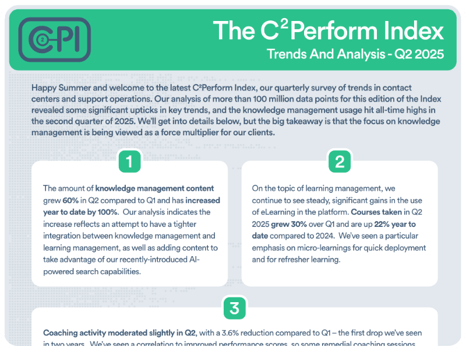Keeping talented call center staff is incredibly difficult at the best of times. Employees often balk at the high stress levels and long hours — which can be exhausting for both workers and managers.
While it’s true that burnout is one of the biggest causes behind voluntary turnover in call centers, there are many other factors that influence call center agents into leaving their posts prematurely. Proactively addressing voluntary employee turnover is crucial for call center success. The cost of employees leaving and having to replace them alone makes prioritizing retention critical for call centers.
The average cost of replacing one of your salaried employees is estimated to be one-half to two times their annual salary. So if your agent is earning $50,000, it will likely cost your organization between $25,000 and $100,000 to replace them.
Let's explore why employees quit and what you can do to keep your A players from jumping ship.
Top Causes of Voluntary Turnover
The employee experience in contact centers comes with high stress. Agents face angry customers regularly and they often lack the training and resources they need to delight customers while hitting their key performance indicators (KPIs).
Without a positive employee experience, contact centers are bound to experience high levels of voluntary turnover. However, stress isn’t the only reason that employees quit working for call centers.
There are many potential reasons for an employee to leave. Here are some of the more common ones:
Lack of Advancement Opportunities
While not all contact center employees want to advance their career, many of them want to see career growth opportunities that they can pursue. In fact, Gallup found that 87 percent of millennials say professional growth and career development opportunities are important to them, with nearly 70 percent of non-millennials saying the same.
Unfortunately, many agents and other call center personnel may assume they’re stuck in a “dead-end job.” This sense of futility or inability to advance can hurt employee engagement and satisfaction.
Many employers do not provide adequate opportunities to help their team members advance. This can be frustrating for someone who is stuck in a position where they feel like they are not able to move forward. Usually, this encourages them to explore other employment opportunities that offer the growth potential they need.
Low Compensation (Both Monetary and Non-Monetary)
While the notion that money motivates people is not surprising, the data showing pay increase potential for your team members is certainly noteworthy. Forbes found that company loyalty does not always pay off — the average team member can expect a three percent annual increase from their current employer, but switching organizations can often yield a 10 to 20 percent increase.
But it’s not just a low paycheck that makes employees feel undervalued. Your team also needs a good benefits package that provides value to their life. This may include affordable health insurance, flexible work options, and travel reimbursements for commuters.
Needless to say, money talks, and if your team feels undervalued, they’re likely to find a better paycheck elsewhere. Or at the very least, they will try to negotiate if they get a competitive offer, and that equips your leadership team with the information they need to either increase their compensation or let them leave voluntarily.
Lack of Work-Life Balance
When it comes to work-life balance, some people thrive when they are able to devote all their time and energy to their job, while others need more of a separation between work and home in order to feel mentally and emotionally balanced.
However, no matter the person, even if your agent loves to take overtime, lacking a work-life balance is not sustainable. Eventually, the stress compounds and affects mental health and physical health, leading to frustrations with the job itself and even resentment toward your organization.
Unfortunately, this is more common than most people think. Deloitte found that about one out of every three employees regularly deal with feelings of exhaustion, stress, and being overwhelmed.
Without the proper amount of support and resources, employees may feel stuck in a kind of negative loop where work overtakes their personal life. Then, they’ll start to look elsewhere for a better work-life balance.
Negative Company Culture
Company culture can have a significant impact on employee engagement. If your culture doesn’t have strong internal communication and if you fail to support collaboration and team building, the effect can be devastating.
Generally speaking, a negative company culture can comprise a variety of different characteristics, but some common signs include:
- A lack of trust and transparency between employees and management
- An absence of recognition or rewards for hard work and progress
- An environment that enables fear or intimidation
- Inconsistent or unfair treatment of employees
Additionally, bad cultures can manifest through failure to provide adequate resources or support to employees, the valuing of profits over people, and an unwillingness to cooperate with employees on improvement initiatives. Any combination of these traits can create a toxic workplace atmosphere that negatively affects both morale and productivity.
Tips for Improving Employee Retention
Knowing why employees quit is just half the battle. Now that you’re aware of the most common causes of voluntary turnover, you need to know the best ways to retain your best employees and support them in long-term growth.
Provide an Employee Wellness Program
Your team’s physical and mental health has a direct impact on productivity, engagement, and even the customer experience. When your employees are feeling spread too thin and overwhelmed, the customer will see that.
As discussed, a poor work-life balance can play a major role in lowered well-being, which leads to disengagement and mounting frustrations.
What’s also notable is the cost of poor well-being in your workplace — Gallup found that businesses experienced $20 million of additional lost opportunity for every 10,000 employees due to their levels of suffering and struggling. Additionally, an average of 15 to 20 percent of total payroll accounts for voluntary turnover costs due to burnout.
This is where an employee wellness program can play a vital role. With a documented, holistic program that supports employees in a variety of wellness areas, you can help your team solve for significant stressors that impact their daily life at work and at home.
For example, let’s say you distribute a wellness survey to your teams and find that their top areas of stress include financial well-being. You can use this feedback to provide targeted wellness support.
In the context of financial wellness, you can provide complimentary access to financial planning workshops or provide live financial planning sessions with a financial planner. You can also give your team members subscriptions to budgeting apps and other useful tools to help them improve their personal finances.
Generally speaking, a wellness program can lead to several benefits for your contact center. Not only can you support employees in better managing their stresses in the office and at home, but you can also save on healthcare costs. In fact, Harvard researchers found that employee wellness programs save companies $3.27 for every dollar spent on healthcare costs.
Open Communication Channels Between Managers and Employees
Let’s say your agent named Adam is nearing his work anniversary. He’s been consistently achieving his goals, and he’s a staple to your culture. He thrives as a mentor for new hires and is a go-to resource for anyone with questions about their role as a support agent.
He’s ready to discuss next steps in your organization. However, if he’s not given a channel to bring up his intentions, he may feel like he is not being supported. And if he can only reach out via email to leadership, he may be concerned about his input falling on deaf ears.
This is just one example of how opening communication between all levels of your organization can be a game changer. Your leadership and management teams need to be proactive in having those conversations.
So, instead of waiting for Adam to raise his hand, create an open channel where managers and employees alike can speak their truth. This may include monthly one-on-ones, quarterly professional development workshops, and showcasing an open door policy via internal communication solutions.
Whatever form fits your team’s needs, you need to ensure that you keep it active and consistent.
Implement Fun Recognition Programs
Effective employee recognition programs are essential in keeping your agents engaged and helping them feel valued. Singing your team’s praises and celebrating their accomplishments also means higher retention rates — an employee who feels recognized is 63 percent more likely to stay at their current job for the next three to six months.
Not only does getting a shout out feel good, it also encourages team members to repeat that behavior and continue looking for ways to achieve their goals in their daily job. Some fun ideas you can implement to praise your team members include the following:
- Create personalized trophies to show appreciation for specific accomplishments.
- Host team outings in fun places outside the office for celebrating team achievements.
- Send gift cards or bonuses to those who go above and beyond.
- Celebrate important milestones (e.g., work anniversaries) publicly with a surprise party.
- Share a leaderboard that lists the top performers and showcase specific performance improvements for key players.
Regardless of how you organize and implement your employee recognition program, make sure it’s fair, consistent, and flexible to suit the unique needs of your team members.
Enhance Your Training and Development Opportunities
Those who are going to thrive at your call center want the ability to expand their skill set and learn new job functions. Regardless of their role and your team structure, it’s important to clearly define growth paths.
You can leverage performance management and employee engagement tools to help organize all the data you need for each individual employee.
For example, C2Perform’s Dynamic Coaching solution enables managers to create growth plans and centralize all coaching activities, with key performance outcomes attached to each coaching session.
With performance management tools, you can align expectations for leaders, managers, and employees, keeping everyone on the same page in regards to each employee’s growth goals, their needs, and their successes as they advance through their training and professional development.
See C2Perform in action by booking a free demo. Our team can show you how to maximize software solutions to keep your employees engaged, happy, and excited to learn and grow with your call center.
 English
English Español
Español





.png?height=350&name=Untitled%20(300%20x%20175%20px).png)



